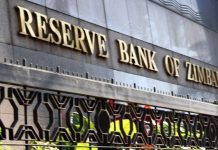Sydney Kawadza
The African Development Bank has predicted that prices of goods in Zimbabwe would stabilize due to the weekly Foreign Currency Auction System introduced in June.
The Bank, in its African Economic Outlook 2021, also predicted a modest economic recovery of 3% for Zimbabwe this year.
However, the economic outlook released during the ongoing Annual General Meetings being held virtually, Zimbabwe’s outlook is clouded by a number of factors.
The Bank said the COVID-19 pandemic and government policies to contain the disease would affect production levels across all sectors.
It further called for a partial easing of border closures to help in the process.
“Modest economic recovery is projected in 2021, if effective measures are taken to stabilize foreign exchange and avoid excessive money creation.
“The industrial and mining sectors are equally faced with reduced competitiveness, low commodity prices, and interruptions in electrical service that disrupt output.
“The problems are exacerbated by debt distress and arrears, and low international reserves that can cover less than one month of imports.”
Zimbabwe’s total public debt is US$11.1 billion (53.9 percent of GDP), of which 95.6 percent is external including US$6.4 billion in arrears to international financial institutions, bilateral, and private creditors.
The country has been in default since 2000 while a Staff Monitored Program with the International Monetary Fund to help Zimbabwe implement economic policies from May 2019 to March 2020 collapsed in September 2019.
Government and the Fund have not agreed to a new arrangement, which would be aimed at helping Zimbabwe clear its arrears.
The AfDB said as a result of the disagreement with the IMF, Zimbabwe will have to continue to rely largely on domestic resource mobilization and borrowing from non-Paris Club members like China.
The international financial institutions will not resume lending until debt arrears are cleared.
The AfDB further indicated that Zimbabwe’s economic situation will remain challenged in 2021 adding that the foreign exchange reforms, especially the weekly Forex auctions, introduced in June 2020, could create price stability and create room for modest economic recovery.
According to the Bank, before the COVID–19 pandemic, Zimbabwe’s economy was already in recession, contracting by 6.0 percent in 2019.
“Output fell because of economic instability and the removal of subsidies on maize meal, fuel, and the removal of subsidies on maize meal, fuel, and COVID–19 pandemic and continued drought led to 10 percent contraction in real GDP in 2020,” the Bank said adding that inflation soared, averaging 622.8 percent in 2020, up from 226.9 percent in 2019.
Foreign exchange reforms were instituted in June 2020, which dampened an inflation that raged an annual rate of 838 percent in July.
Fiscal and current account deficits also recovered after July, but both deteriorated for the year as a whole.
The budget deficit rose from 2.7 percent in 2019 to 2.9 percent in 2020, while the current account went from a surplus of 1.1 percent of GDP in 2019 to a deficit of 1.9 percent in 2020.
The exchange rate depreciated $2.5 in February 2019 and stabilizing around $82 to the US dollar in December 2020.
Poverty stood at 70.5 percent in 2019 while unemployment remained high at over 21 percent.
The AfDB also noted that the banking system in Zimbabwe was stable although the financial institutions had some room to increase credit.
“The loan-to-deposit ratio was 38. fabriquer viagra 8 percent in 2020 against a benchmark of 70 percent. Non-performing loans are at 3.23 percent, well under the regulatory benchmark of 5 percent.
“The capital adequacy ratio is more than three times the regulatory requirement of 12 percent.”















